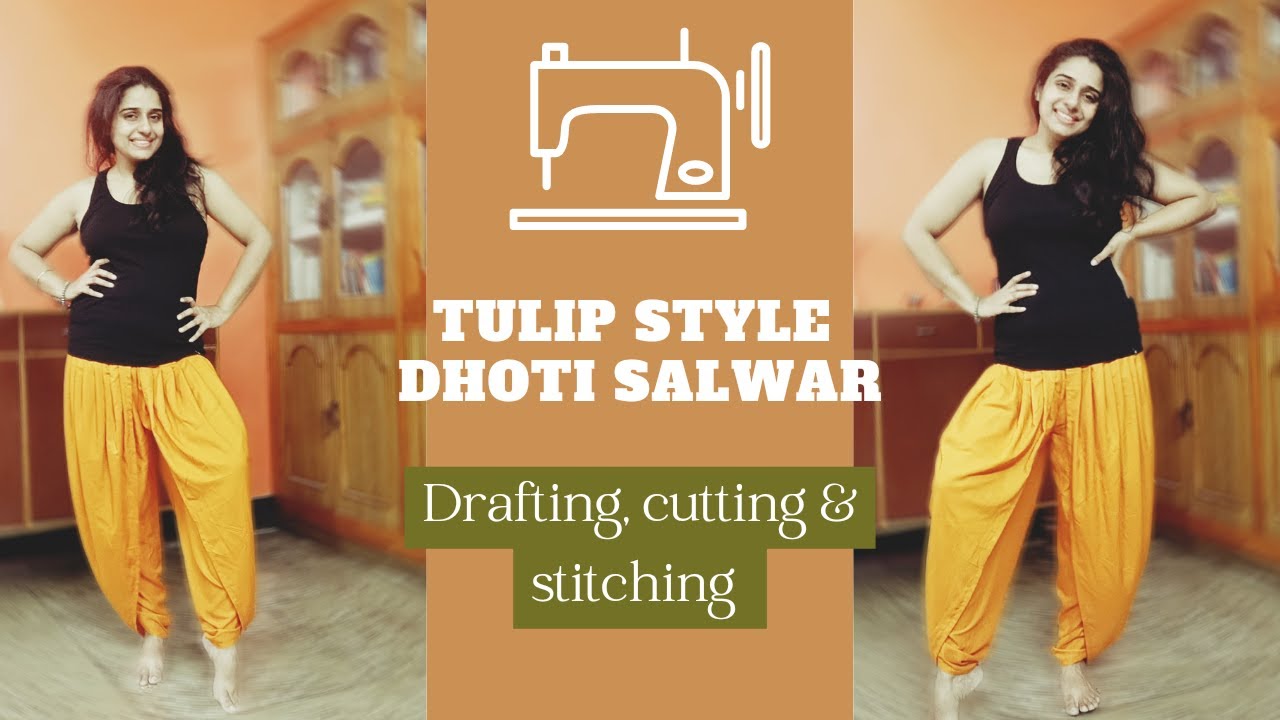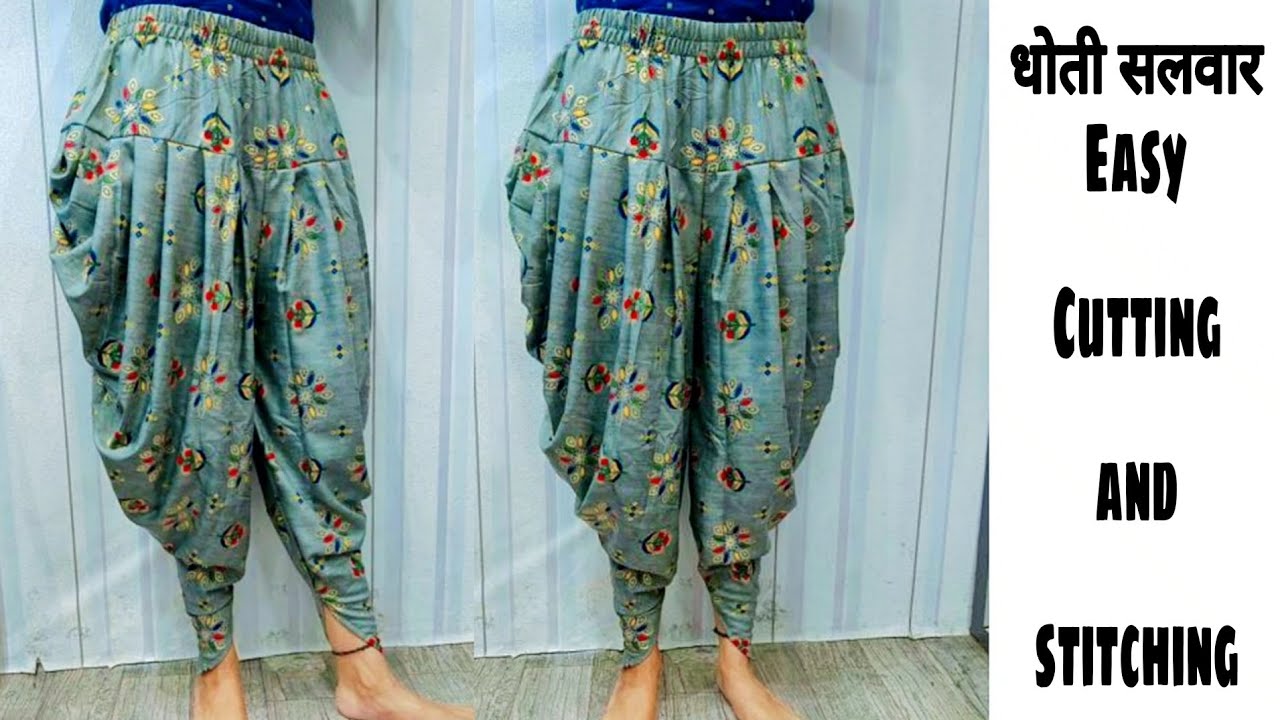Hey there! Are you ready to dive into a fun DIY project? Today, we’re exploring the wonderful world of Dhoti Salwar—a stylish and traditional outfit that combines comfort and elegance. Originating from Indian culture, the dhoti salwar has become a beloved choice for many, especially during festivals and special occasions. Whether you're looking to wear it for a cultural event or simply want to add a unique piece to your wardrobe, making your own dhoti salwar is not only satisfying but also a great way to showcase your personal style!
Materials Needed for Your Dhoti Salwar

Before we jump into the making process, let’s gather all the materials you’ll need to create your stunning dhoti salwar. Don’t worry; most of these items are easy to find, and you might even have some of them at home!
- Fabric: You will need about 2.5 to 3 meters of fabric. Popular choices include cotton, silk, or any lightweight material that drapes well.
- Thread: Choose a thread that matches your fabric color. Cotton thread is usually a good choice for comfort and durability.
- Measuring Tape: A measuring tape is essential to ensure your pieces are cut to the right size.
- Fabric Scissors: Sharp scissors will make cutting fabric much easier and give you clean edges.
- Sewing Machine: While hand-sewing is an option, a sewing machine will speed up the process significantly.
- Pins: Use pins to hold the fabric in place while you sew to avoid any slipping.
- Iron: An iron is crucial for pressing seams and ensuring that your fabric lays flat.
- Pattern Paper (optional): If you want to create a custom pattern or make adjustments, pattern paper can be quite handy.
Once you have all of your materials ready, you’ll be one step closer to creating your beautiful dhoti salwar. Don't worry if it feels like a lot at first; each piece plays a significant role in crafting a garment that not only looks good but feels comfortable too. So take a moment to collect your supplies, and get ready to unleash your creativity!
Also Read This: Discovering the Roots of Christianity with Insightful Videos on Dailymotion
3. Step-by-Step Instructions to Make Dhoti Salwar

Ready to unleash your inner designer? Making a dhoti salwar at home can be a fun and rewarding project. With just a few materials and some basic sewing skills, you’ll have a stunning outfit that’s as comfortable as it is fashionable. Let’s dive into the step-by-step instructions!
Materials Needed:
- 2-3 meters of fabric (cotton, silk, or any fabric of your choice)
- Measuring tape
- Tailor’s chalk or fabric marker
- Scissors
- Sewing machine or needle and thread
- Pins
- Elastic band (optional)
Step 1: Measurements
Start by taking your measurements. You’ll need your waist, hips, and the desired length of your dhoti salwar. For a traditional look, the length usually falls between the calf and ankle. Note these measurements down.
Step 2: Cutting the Fabric
Now, fold your fabric in half. You can create long triangular shapes that will fold beautifully. For a classic dhoti, mark the fabric at an angle from the waistline to the hemline. Use your tailor’s chalk to outline this. The width at the bottom should be wider than the top to allow for that flowy effect. Cut along the lines carefully!
Step 3: Making the Waistband
For the waistband, take a strip of fabric that is 4-5 inches wide and the same length as your waist measurement plus some extra for seams and overlaps. Fold the strip in half lengthwise and sew it to create a more finished look. If you want to add an elastic band for comfort, now is the time! Just ensure it fits comfortably around your waist.
Step 4: Assembly
With your main pieces cut out and the waistband ready, it’s time to start assembling. Pin the waistband to the upper part of your dhoti fabric. If you are using an elastic band, remember to stretch it while pinning. Sew them together using a straight stitch, making sure it’s secure!
Step 5: Creating the Dhoti Look
Here’s where the magic happens! To create the dhoti style, fold the fabric in arrangements that give you the layered effect. This typically involves bringing parts of the fabric together and pinning them on the side of the leg. Play with the draping until it feels right and secure everything in place with stitches or a few pins if you're still perfecting the layout.
Step 6: Finishing Touches
Finally, hem the edges of your dhoti salwar for a neat finish. You can add embellishments like embroidery or lace at the hem for a personal touch. Voila! You have created your very own dhoti salwar!
Also Read This: Watch How to Create a Paper Boat: Video on Dailymotion
4. Tips for Choosing the Right Fabric
Choosing the right fabric for your dhoti salwar can make all the difference in how it looks and feels. Here are some tips to help you select the ideal material:
1. Consider the Occasion
Think about when and where you’ll be wearing your dhoti salwar. For festive occasions, fabrics like silk or brocade give a rich look. If you’re looking for something casual, lightweight cotton or linen works wonders!
2. Look for Breathability
Especially in warmer climates, you want a fabric that breathes well. Natural fibers like cotton are fantastic for this—keeping you cool and comfortable against your skin.
3. Check the Fall
The drape of the fabric is crucial for dhoti salwars. Look for fabrics that have a good flow. Some materials, like georgette or crepe, beautifully cascade and create that elegant look.
4. Weight Matters
A heavier fabric might give you that structured look you want for formal events, while lighter materials are excellent for leisurely days. Always consider how the weight of the fabric will impact the overall silhouette.
5. Test the Color and Pattern
Color selection can reflect your personality and style. Don’t shy away from vibrant hues or playful patterns, but ensure they complement your skin tone and the occasion. A simple print can elevate a plain design, while bold graphics may be perfect for a statement outfit.
6. Feel Before You Sew
Lastly, always touch and feel the fabric before purchasing. This way, you can make sure it aligns with your comfort preferences. Whether it’s soft, textured, or shiny, make sure it’s something you’ll enjoy wearing!
By keeping these tips in mind, you’re sure to choose a fabric that not only looks good but feels great too. Happy sewing!
Also Read This: Integrating Dailymotion Video API into Your Website Made Easy
5. Styling Your Dhoti Salwar: Outfit Ideas
Now that you’ve created your beautiful dhoti salwar, it’s time to think about how to style it! The versatility of dhoti salwar makes it a fantastic addition to any wardrobe. Whether you’re dressing up for a special occasion or keeping it casual for a day out, here are some outfit ideas to get you started:
- Casual Chic: Pair your dhoti salwar with a simple solid-colored kurta or a loose-fitting tunic. This effortless look is perfect for brunch dates or casual meetings. Complete the outfit with juttis or flat sandals for comfort.
- Festival Ready: For festive occasions, go for a heavily embroidered or embellished kurta. A pair of jhumkas and a clutch will elevate your look. Think about adding some statement jewelry to really stand out!
- Layered Look: Add a long waistcoat or an open-front jacket to your dhoti salwar ensemble. This layering technique not only adds dimension but also allows you to play with colors and textures. Choose a contrasting or complementary color for a trendy vibe.
- Work Wear: Combine your dhoti salwar with a fitted shirt or a tailored blazer. It's a great way to infuse traditional wear into your professional attire. A pair of colorful pumps can add a fun twist to your office chic!
- Evening Out: Dress up your dhoti salwar with a sequined top or a stylish off-shoulder blouse. A chic belt can help accentuate the waist, while strappy heels will give you that glam look for a night out.
Don’t forget about accessories—play with different styles of earrings, neckpieces, and even handbags to complete your look. And most importantly, wear your dhoti salwar with confidence! After all, that’s what completes any outfit.
Also Read This: The Popularity of YouTube vs Dailymotion Key Differences and User Preferences
6. Caring for Your Dhoti Salwar
Caring for your dhoti salwar is essential to keep it looking fresh and vibrant for years to come. Here are some practical tips to help you maintain the beauty and longevity of your handmade creation:
- Washing: Always check the care instructions on the fabric. Most dhoti salwars can be hand-washed gently in cold water with a mild detergent. Avoid using harsh chemicals that might damage the fabric.
- Drying: After washing, hang your dhoti salwar to dry in a shaded area. Direct sunlight can fade colors and weaken fibers, so it's best to keep it out of intense sunlight.
- Ironing: If your dhoti salwar is made of cotton or silk, it might wrinkle after washing. Iron it on a low setting while it's slightly damp or use a steam iron to remove wrinkles. Always place a piece of cloth between the iron and the fabric to prevent any burn marks.
- Storing: When storing your dhoti salwar, fold it neatly instead of hanging it. This prevents stretching and maintains the shape. You can also store it with a few lavender sachets to keep it smelling fresh and to ward off any insects.
- Spot Cleaning: For any spills or stains, act quickly! Blot—not rub—the stain with a clean, damp cloth. This helps minimize the damage. For tougher stains, consider consulting a professional cleaner.
With the right care, your dhoti salwar will remain a stylish and cherished piece in your wardrobe. Remember, taking care of your clothing not only prolongs their life but also enhances your overall dressing experience!
Conclusion and Additional Resources
Creating a DIY Dhoti Salwar can be a rewarding and enjoyable project that blends tradition with personal style. By following the steps outlined in this guide, you can easily craft a beautiful pair that reflects your unique taste. Remember, practice makes perfect, so don't hesitate to experiment with different fabrics and styles!
For those who wish to dive deeper into the art of traditional Indian clothing, here are some *additional resources* that may be helpful:
- Video Tutorials on YouTube - Visual guides to help you refine your technique.
- Pinterest Boards - Inspiration for designs and patterns you can try.
- Sewing Patterns Websites - Find patterns that suit your style, including Dhoti Salwar templates.
- Sewing Community on Reddit - A place to ask questions and share your creations with fellow sewing enthusiasts.
By utilizing these resources, you can not only enhance your sewing skills but also enjoy a vibrant community of creators who share your passion for DIY fashion. Happy sewing!
 admin
admin








